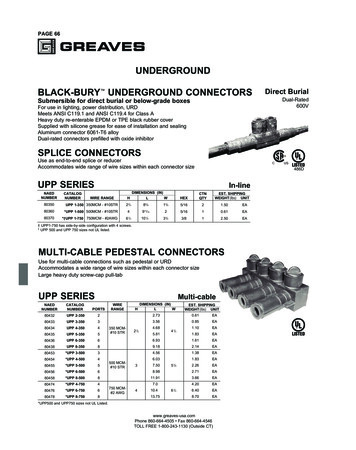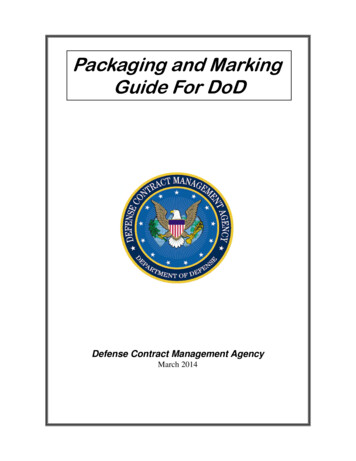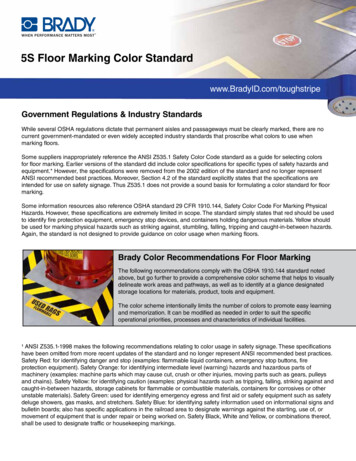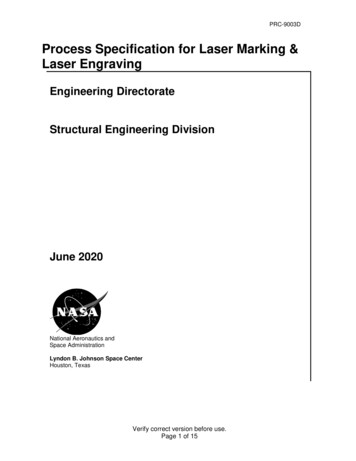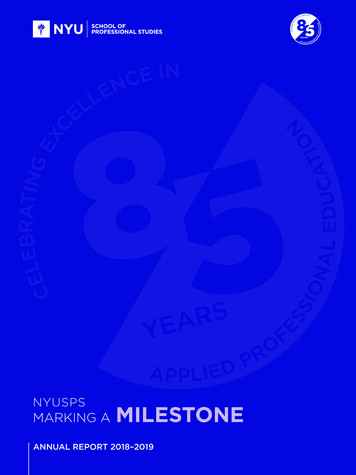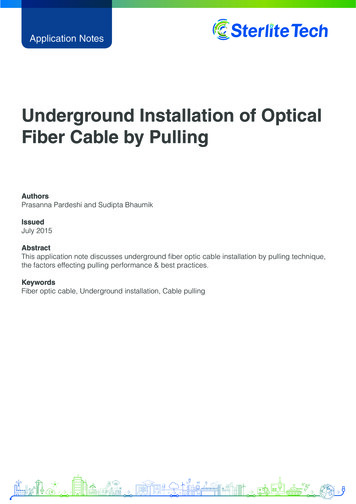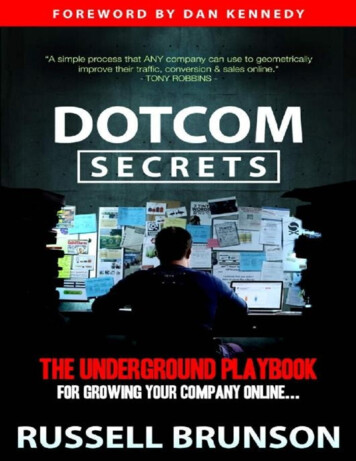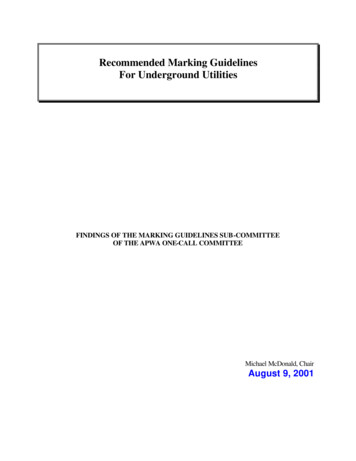
Transcription
Recommended Marking GuidelinesFor Underground UtilitiesFINDINGS OF THE MARKING GUIDELINES SUB-COMMITTEEOF THE APWA ONE-CALL COMMITTEEMichael McDonald, ChairAugust 9, 2001
Recommended Marking Guidelines for Underground UtilitiesAugust 9, 2001Page iTABLE OF CONTENTSBackground .1Discussion .1Methodology.2Marking Guidelines Sub-Committee Members.3Recommendations .4Appendix A – Recommended Marking Guidelines .5Appendix B – Responses to Comments Received .10Appendix C – Request for Comments Posted on the Internet.25Proposed Resolution .27i
Recommended Marking GuidelinesFor Underground UtilitiesBackgroundWhy are the Guidelines for marking underground facilities needed? TheAmerican Public Works Association took the lead in the development of the colorcodes for the identification of underground-buried facilities that have beenadopted throughout the United States and many other countries. Currentlythroughout the nation and the world for that matter, the placement andreplacement of underground facilities thrives.The challenges faced by excavators are enormous enough on top of the fact thatthey must deal with different legislative requirements from different municipalitiesand states. As a result of this drive to place more and more of our infrastructureunderground, a large number of contractors are crossing both local and stateboundaries.At the heart of damage prevention is improved information accuracy andconsistency in communication between excavators and operators of undergroundfacilities.DiscussionBecause of these issues, One Call Systems International attempted to createMarking Guidelines in the early 90’s. This effort failed however because nostakeholder could reach agreement, and there was no common ground.The Transportation Equity Act for the 21st Century (TEA 21), and the highvisibility damages to underground facilities that lead up to it changed all this.
Recommended Marking Guidelines for Underground UtilitiesAugust 9, 2001Page 2Because of this Bill, the Department of Transportation responded to the requestfor Best Practices relating to damage prevention.These best practices covered everything from the design of a project to thecompletion and mapping of underground installations as well as emergingtechnologies.Membership of the APWA took a lead on this effort and through the relationshipsbuilt through this process it was agreed that the time was right to move forwardwith these guidelines.These proposed guidelines are not all inclusive, nor with emerging technologies,should anything we propose be.MethodologyThe process we adopted is as follows:First, make sure that there was accurate representation from all stakeholders aswell as support from APWA staff. Our Stake holders represented the followingorganizations and Trade Associations; American Gas Association, EdisonElectrical Institute, the National Telecommunications Damage PreventionCouncil, One Call Systems International, the National Utility ContractorsAssociation, the AGC, the National Utility Locating Contractors Association(NULCA), Locate Equipment Manufacturers Association, as well as input fromthe info-now community due to the web posting.There were nine responses from the recommendations posting on the web.Several comments expressed concerns relating to the marking of no/conflict, orall clear of facilities. Actually this was an oversight by the committee before theposting of the guidelines on the web and the following changes have been made:If a no conflict exists at the excavation site instead of “GAS/OK”, a marking2
Recommended Marking Guidelines for Underground UtilitiesAugust 9, 2001Page 3should be placed indicating at a minimum the initials of the underground facilityowner. Example: NO/PG&E, or a circle with a / through it accompanied by theowners initials. It was also suggested that the company segment be identified aswell. As stated in a response from AT&T, “Numerous government organizationswho have expanded their public works departments and utility units from typicalwater, sewer, street, and drain operators into power, telephone, cable TV, ISP,and other telecommunications carriers.”Finally, there has been a great deal of concern raised about the amount of paintplaced on the ground. This was a concern of the committee as well, however ofa higher concern was that of Public Safety and the reliability of the nations’underground infrastructure.All responses and comments from this posting have been compiled as well as myresponses and are included as appendices.The process for all decisions was based on obtaining consensus of all parties.Everything you see within this proposal are suggested guidelines that allparticipants could live with and agreed upon. Many issues still exist that we couldnot reach agreement on, however it is the committee’s feeling that this indeed isa step in the right direction.Marking Guidelines Sub-Committee MembersMike McDonald, Chair – American Public Works Association (APWA)Gary McKay – Detroit EdisonTim Boatfield – Georgia Utility Protection CenterJim Barron – National Utility Contractors Association (NUCA)Allen Gray – Associated General Contractors of America (AGC)Jacque Washburn – 3M CorporationTom Jackson – Georgia PowerMorgan Abele – National Utility Locating Contractors Association (NULCA)Ron Boes – American Gas Association (AGA)Danny Barret – National Telecommunication Damage Prevention Council (NTDPC)Dan Simpson – WorldComBill Kieger – Pennsylvania One-Call3
Recommended Marking Guidelines for Underground UtilitiesAugust 9, 2001Page 4RecommendationsWe respectfully ask the Board to adopt the following Resolution endorsing theRecommended Marking Guidelines in conjunction with the current Color Codes.Respectfully Submitted by the Marking Guidelines Sub Committee,Michael McDonald, Chair4
Recommended Marking Guidelines for Underground UtilitiesAugust 9, 2001Page 5Appendix A -- Recommended Marking Guidelines for Underground Utilities5
Recommended Marking Guidelines for Underground UtilitiesAugust 9, 2001Page 66
Recommended Marking Guidelines for Underground UtilitiesAugust 9, 2001Page 77
Recommended Marking Guidelines for Underground UtilitiesAugust 9, 2001Page 88
Recommended Marking Guidelines for Underground UtilitiesAugust 9, 2001Page 99
Recommended Marking Guidelines for Underground UtilitiesAugust 9, 2001Page 10Appendix B – Responses to Comments ReceivedResponse to Larry Ferguson:Larry the committee agrees totally. Your recommendation will be part of thereport delivered to the APWA Board of Directors for approval. Thank youagain for taking the time.-----Original Message----From: Ferguson, Larry D [mailto:Larry.D.Ferguson@Williams.com]Sent: Friday, June 22, 2001 9:17 PMTo: Teresa HonCc: Haberkorn, Michael ASubject: Suggestion to showing no gas in areaI work for Williams Gas Pipeline and we are in the same areas as localDistribution companies -- In the past we had a real problem with theLocal gas company marking no gas -- but guess what Williams had a highPressure main 3 feet away. It is imperative that the company Logo orInitials be placed in the locate marks to show which company has noFacility in the area.Response to Dan Munthe:Dan-Thanks for your response. I will respond in the order received.(Line Markings)The premise of arrows at the ends of the requested area makes goodsense, however the committee could not reach consensus on a standard orrecommendation as to how far apart marks should be based off ofvariables with field conditions.(Corridor Markings)Even though this has the potential for abuse, this was a compromisereached between the facility owners and the nations two largest ContractorAssociations, the A.G.C., and the National Utility Contractor Association.These marks are to be used when the material, size and number of facilitiesare not known.(High Pressure)No consensus could be reached on acronyms other than High Pressure.This was partly due to no conflict symbology. It was agreed that any noconflict or site clear indication should include the initials of the companywithout facilities in the dig area. This could lead to more confusion thancurrently exists.10
Recommended Marking Guidelines for Underground UtilitiesAugust 9, 2001Page 11(Marking Offsets)If every underground facility, road or permanent surface ran north to southor east to west, this would be a viable option.(Marking Buried Splices, Valves, and Manholes)The proposed guidelines are all the Committee could reach consensus on.(What was not addressed)1. White Markings: No consensus could be reached due to varied locallegislation and whether this should be required on small jobs.2. Addressed with corridor marking3. Addressed with corridor marking4. No consensus could be reached5. No consensus could be reached6. No consensus could be reached along with magnetic tape-----Original Message----From: Munthe, Dan [mailto:Dan.Munthe@state.mn.us]Sent: Tuesday, August 21, 2001 12:12 PMTo: 'Mike McDonald'; Teresa HonSubject: RE: Proposed marking guidelinesSome random thoughts in no particular order."Line Markings"Arrows should be used only at the ends of the requested area (as indicated onthe one call ticket). This would indicate that the facility continues (of course)."Corridor Markings"This could potentially be abused, i.e. if two facilities shared a 10'easement could a locate technician then paint a 10' corridor marking across thewhole easement?"High Pressure"H.P. High Pressure. It would be beneficial to develop a standardized list ofacronyms for other situations as well.COM CommunicationsELC ElectricSTL SteelEMS Electronic Marking System deviceCON Concrete and etc."Marking Offsets"direction (N,S,E,and W) should be included."No Conflict"Should only be used with an informational flag (translucent in color) that11
Recommended Marking Guidelines for Underground UtilitiesAugust 9, 2001Page 12identifies the facility owner and included locate ticket information so thatthe flag can not be displaced and used elsewhere."Marking Buried Splices, Valves, and Manholes"Should be differentiation between buried splices and valves and vaults.Also, these standards do not address.1.2.3.4.5.6.White MarkingsSize indications (anything over 2" diameter).Material indications (steel, plastic, clay tile, etc.)Spacing of the marksFlags (standardization; owner & phone number?) and frequency of use.Alternative markings; stake chasersThanks,Dan MuntheMinnesota Office of Pipeline Safety651-296-7364Response to Robert Davis:Thank you for your support Mr. Davis. The reason for "RecommendedMarking Guidelines" verses "Marking Standards" is as follows.Emerging technologies for our industry is changing the way we dobusiness at a rapid pace. I can remember going on jobsites with my fatherwatching him locate underground facilities with witching rods. Today I goto jobsites and see demonstrations of the latest generations of GroundPenetrating Radar.Our hope is that these guidelines if adopted by the APWA Board be liquidand easily modified verses an ANSI standard.-----Original Message----From: Robert H. Davis [mailto:rhdservices@mindspring.com]Sent: Thursday, August 09, 2001 5:58 AMTo: Teresa HonCc: Tim Boatfield; Hans WonnebergerSubject: Marking Guidelines FeedbackI cannot offer any specific input at this time, only a strong interest.I just became aware of this effort from Tim Boatfield (GAUPC).My firm is in the private locating business, locating not only on private property,but often in the right-of-way. We have been encountering many more types of12
Recommended Marking Guidelines for Underground UtilitiesAugust 9, 2001Page 13facilities than there are official APWA designations over the years. Obviously mytechnicians "made up" markings. It has become more of a problem as we havemore technicians and surveyors that we work with and need to standardize.I think your work in this area is important. However, I am not clear as to why youwant to change from develping standards to only "recommended" markings.Bob DavisRHD Services, Inc.630 10th Street, N.W.Atlanta, Ga. 30318404-634-6152Fax 404-874-8586Response to Patricia Koeb:Patricia, thank you for your response.Your comments regarding "no conflict" or "site clear" have beenaddressed in the following manner.Because in many situations there could theoretically be two companies inthe same area of excavation, i.e.: Missouri Gas and Williams Co. Highpressure, this marking guideline will be recommended.N/MGE or N/WILLIAMS or N/WGP (whatever initials the facility ownerdetermines).Because of utilities initialing their facilities the committee could not cometo a consensus on the use of any other acronyms other than Highpressure.-----Original Message----From: Patricia Koeb [mailto:patricia.koeb@southernunionco.com]Sent: Wednesday, August 08, 2001 1:36 PMTo: Teresa HonCc: Melvin BurnsSubject: Feedback concerning Proposed Marking GuidelinesMissouri Gas EnergyEngineering Department223 GillisKansas City, MO. 641208 August 2001To whom it may concern:13
Recommended Marking Guidelines for Underground UtilitiesAugust 9, 2001Page 14Regarding the APWA June 6th, 2001 proposed utility marking guideline,Missouri Gas Energy would like to comment on 2 separate markings:No Conflict (No utilities within the requested area)GAS/OKMGE personnel think that: GAS & (circle with / thru it) may be moreappropriate or possibly just no marking; if that utility is not in ing Gas Lines - High Pressure- could also be Plastic - PE or Cast Iron - CI-------------------------------------Your attention to these suggestions are appreciated! For further questions,please contact: Patricia Koeb at 816-472-3485 ro Melvin Burns at 816-472-3464.Sincerely,Patricia KoebResponse to Gary Auvil:Gary- the committee agrees with your issue regarding no conflict, siteclear, and the potential for disastrous results. Your recommendation andcomments have been incorporated into the final report for the APWA Boardof Directors.As with you a large concern for the industry is the issue of over marking. Agreat deal of discussion and compromise took place between thecontractors associations as well as the owners of underground facilities.Your concerns on this matter will be addressed in the report as well.Thank you again for your participation.-----Original Message----From: Auvil, Gary [mailto:Auvil.Gary@broadband.att.com]Sent: Tuesday, August 07, 2001 1:47 PMTo: Teresa HonSubject: Marking Guidelines FeedbackAs a representative of a multi business / multi facility company, I see potentialproblems with the "clear area - no utility" marking proposal. If, for example, AT&Twere to mark an area "No TEL" it might imply to Excavators that there were no14
Recommended Marking Guidelines for Underground UtilitiesAugust 9, 2001Page 15telephone lines to worry about, while Sprint, MCI WorldCom, and other localtelephone companies may have facilities in the area. Additionally, manycompanies now operate separate and distinct businesses that have been mergedtogether under one name, with segment identifiers. AT&T for instance, has AT&TLong Distance (designated "LD") and AT&T Broadband (designated "BB"). I amalso aware of numerous local government organizations who have expandedtheir public works departments and utility units from typical water, sewer, street,and drain operators into power, telephone, cable TV, ISP, and othertelecommunications carriers.All marks should identify the company or entity, and further identify by companysegment. Tickets generated by the local One Call entity will list the membercompanies, giving the excavator names of companies and segments ordepartments to look for.Finally, any methods or standards developed should attempt to minimizeThe amount of marks required and mandate spray chalk or other products thatWill dissipate, or can easily be removed or covered after work is complete.Left over marks are becoming deceptive and a form of eye pollution!Gary AuvilDirector - New ConstructionSan Francisco Bay Market550 Garcia AvenuePittsburg, CA. 94565925.432.0500 ext. 225925.382.7443 Wireless925.439.9537 Faxauvil.gary@broadband.att.comResponse to Bill Phillips:Bill, thank you for your response.I understand your preference for generic facility identification howeverdamage to underground facilities and public safety require more.I will use NO/GAS as an example:A gas distribution company in the mid-west marked a N/G on the groundindicating no conflict for gas at the job site. A cable TV construction crewarrived on the job prior to the due date of the marking request, saw the N/Gon the ground and dug into a high pressure gas line that had not arrived tomark yet.This same scenario has applied to many companies; AT&T, Sprint, MCI, ElPaso Natural Gas etc.15
Recommended Marking Guidelines for Underground UtilitiesAugust 9, 2001Page 16The proposed marking guidelines were developed jointly between facilityowners and the nations two largest Contractor Associations, the AGC, andNational Utility Contractors Association.The only recommendations to be made to the APWA Board of Directors willbe those that consensus could be reached upon.Thank you again for your comments.-----Original Message----From: Phillips, Bill [mailto:bphillip@czn.com]Sent: Tuesday, August 07, 2001 10:47 AMTo: Teresa HonCc: Farrow, MikeSubject: Marking Guidelines FeedbackThis is some feed back from the fieldI only care that the facilities are marked so that the contractorunderstands. I prefer generic facility designations such as TEL OK fornotification of no conflicts. Most contractors don't know who the localCompany is. This may be a problem for multiple CATV vendors, but theyusually are in common trenches anyway.Bill PhillipsOperations SupervisorPSC West916-686-3032916-686-9528 faxResponse to Bruce Bocking:Bruce thanks you for your remarks and your concerns. I will attempt toaddress them in the order received. Please keep in mind theserecommendations were reached by consensus and anything that could notbe agreed to was not included.1. Corridor Markings were developed for the excavating community basedon a need to know how many facilities may be within a given trench. Thecommittee agrees that this may not be warranted for most Gas Companieshowever; it is very necessary for Electric and Communication distributioncompanies. In many states the definition of what a facility actually is notspelled out in the legislation. Many underground maps of olderinstallations as well may not show the number of facilities. Excessive paintis a concern of all, however public safety is of greater concern.2. Your comments relating to no conflict are right on target and have beenadopted for the Boards approval.16
Recommended Marking Guidelines for Underground UtilitiesAugust 9, 2001Page 173. At the national level there is a great need in both the Electric andCommunications industries. Electronic Markers are used for the following:service stub-outs, junction boxes, conduit stub outs, and with emergingtechnologies data warehousing of facility installation and maintenanceinformation. The committee could
more technicians and surveyors that we work with and need to standardize. I think your work in this area is important. However, I am not clear as to why you want to change from develping standards to only "recommended" markings. Bob Davis RHD Services, Inc. 630 10th Stre
